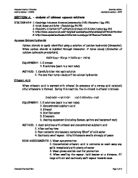Ethanoic Acid
When ethanoic acid is warmed with ethanol (in presence of a strong acid catalyst) ethyl ethanoate is formed. During this reaction, the O-H bond in ethanol is broken.
CH3CH2OH + H3C-C-OH H3C-C-OCH2CH3 + H2O
EQUIPMENT: 1. 5 solutions (each in a test tube)
2. Concentrated sulphuric acid
3. Ethanol
4. Distilled water
5. 5 beakers
6. Heating equipment (including Bunsen, splints and heatproof mat)
METHOD: 1. Heat solutions with ethanol and concentrated sulphuric acid
2. Allow cooling time
3. Pour contents into beakers containing 50cm3 of cold water
4. Cautiously smell vapour. Ethyl Ethanoate smells strongly of pears
RISK ASSESSMENTS: 1. Wear eye protection
2. Concentrated ethanoic acid is corrosive so wash away any spills immediately with plenty of water
3. Wear gloves and lab coat for protection
4. When smelling the vapour, hold beaker at a distance, fill lungs with air and cautiously waft vapour towards nose
Nitric Acid
To completely identify an acid, you need to test for the anion. We need to test for the nitrate ion (NO3-). To do this, we need to boil the suspected nitrate with sodium hydroxide solution and fine aluminium powder. The fumes produced contain ammonia.
Now test for ammonia using hydrochloric acid. When a strip of filter paper is soaked in concentrated hydrochloric acid and exposed to ammonia gas, a white smoke made of fine ammonium chloride particles is produced.
Aluminium powder (a reducing agent) converts the nitrate ion (NO3-) into ammonia gas (NH3).
concentrated hydrochloric acid + ammonia → ammonium chloride
HCl (conc) + NH3 (g) → NH4Cl (s)
EQUIPMENT: 1. Sodium hydroxide solution
2. Fine aluminium powder
3. Hydrochloric acid
4. Filter paper
5. 5 beakers (one with each solution in it)
6. Heating equipment (including Bunsen, splints and heatproof mat)
METHOD: 1. To each solution add aluminium powder and sodium hydroxide solution
- Boil. Meanwhile soak filter paper in hydrochloric acid
- Expose piece filter paper to gas
- If nitric acid (and ammonia gas is present) white smoke will be produced from the filter paper
AQUEOUS POTASSIUM BROMIDE
Halide ions react with silver ions to from precipitates with various colours and varying tendencies to redissolve in ammonia solution.
EQUIPMENT: 1. 5 solutions (each in a test tube)
2. Dilute nitric acid
3. Silver nitrate solution
4. Pipettes
METHOD: 1. To each solution add dilute nitric acid and silver nitrate solution
2. If bromide ions are present, a pale yellow precipitate of silver bromide will form.
AQUEOUS SODIUM CHLORIDE
This is exactly the same as above but if chloride ions are present, a white precipitate of silver chloride will form.
SECTION B - determination of concentration of nitric acid
TITRATION PROCEDURE:
EQUIPMENT:
- Nitric acid
- Sodium carbonate
(0.500mol dm-3)
- Methyl orange
- Burette
- Funnel
- Measuring cylinder
- Pipette
- Beaker
- Conical flask
- Clamp/stand
- White tile
- Safety goggles
METHOD:
- Set up the clamp stand and burette
- Making sure tap is closed, pour acid into burette
- Place beaker underneath and expel some of the liquid (to remove air bubbles)
-
Refill with acid until reading reaches 0cm3
- Remove funnel
-
Measure 25cm3 of sodium carbonate and put into conical flask
- Add 3 drops of methyl orange indicator and mix
- Place conical flask on white tile and begin titration
- Slowly add small amounts of the titrant from the burette, swirling the mixture between additions
- As soon as the solution turns pink (end-point of reaction) stop the flow of acid from the burette and measure how much has been used
- Repeat the experiment 3 times for more accurate results and use the average in calculations
Chemical Practical Plan Page of 3







